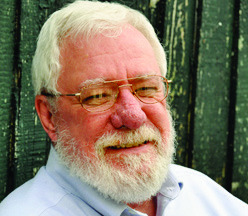Bradshaw
Everybody who saw them seemed to have an opinion about the big bones on display at the Dupre Barber Shop in Eunice in March 1943. Delino Miller brought them to the shop. He said his grandfather found them about 1895 in the Atchafalaya Basin, but he didn’t know much else about them.
They appeared to be part of a huge backbone and several ribs ranging in length from three feet to more than five feet long. Most speculators guessed that they came from a whale or an elephant but wondered how either one ended up in the Atchafalaya swamp.
I’d bet they came from an elephant, or, more precisely, from a mastodon, a distant cousin of modern elephants. The experts say the leaf-eating mastodons roamed around North America until about 12,000 years ago, which was just about when a meandering Mississippi River began to form the Basin.
They may also have roamed the prairies. Linguist William Read wrote in his study of Louisiana French that the town name Mamou is derived from mammouth, the French word for mastodon. He refers to an early map that designates the area between Bayou des Cannes and Bayou Nezpiqué as Prairie Mammouth. (Louisiana French, LSU Press, 1931.)

Bradshaw
Some other linguists suggest that the mammouths on the prairie could have been bison. They say the Acadians used the word for any big animal. Father Jules Daigle does not list mammouth in his Cajun French dictionary (A Dictionary of the Cajun Language, 1984). He does list mamou, which he defines only as a medicinal plant used to fight colds.
Linguistics aside, I argue for the elephant because the barbershop bones are not the only mastodon bones we know about, and some of them did come from the prairies.
The town of Carencro is supposed to be named for carrion crows (buzzards), that gathered nearby to feast on mastodon remains. In April 1802 colonial administrator Martin Duralde wrote to naturalist William Dunbar about a legend that “a beast of enormous size” had died there.
“About the year 1760, or a little after,” Duralde wrote, “chance led some person to the brink of a little bay, called Carencro, where there were heaps of bones. They were sound and of an enormous size. … Their length, their size, and above all, one or two Teeth . . . led the Spectators to judge … that this was the entire skeleton of an Elephant. … Mr. Peter Nezat, a man of strict veracity … to whom the place belongs, has assured me that there was enough of the bones to load … at least one strong cart,” Duralde also recorded that a man named Alexander Fontenot found on his property “an extraordinary tooth” that he believed had once been in an elephant’s mouth. And John Tesson, “a sincere and honest man” found the remains of “an enormous jaw bone” that weighed at least 25 pounds and that he supposed “could only belong to an Elephant.”
All of this prompted Dr W.M. Carpenter to survey the Opelousas prairie during the summer of 1838. He was a medical doctor and dean of the original University of Louisiana (as Tulane was first called) who a biographer describes as “a noted Southern natural scientist.” He said he visited “three localities at which remains of the mastodon have been found.” In 1839, he wrote a scholarly paper on the excavation of a mastodon near Opelousas and suggested there were others to be found. “On all these prairies,” Carpenter wrote, “there are ponds which … seem to be gradually filling up with vegetable matter, and are no doubt rich in fossils of the mastodon, and perhaps other animals.” He said cattlemen deepening one pond during a drought uncovered a mastodon skull, some of its vertebrae, and some ribs. But then the drought broke and rainwater covered the big bones. They may still be there. When Carpenter wrote his letter the pond had “never been dug since.” Unfortunately, he didn’t say exactly where it was.
More recently, workmen digging at the B.F. Trappey canning plant on the Vermilion River in May 1970 turned up bones that archaeologist Jon Gibson identified as those of a mastodon. Still more recently, mastodon bones were uncovered in 1980, when a sensational drilling accident caused Lake Peigneur to drain into the Jefferson Island salt mine in Iberia Parish.
If you happen to find a big bone in the pond on your old family farm, it’s probably worth something, but value seems to depend on how badly the buyer wants it. You can search on the net and see them offered for sale at widely varying prices. If you want to buy one, be careful – the least expensive ones are described way down in the fine print as “a plastic replica.”
You can contact Jim Bradshaw at [email protected] or P.O. Box 1121, Washington LA 70589.


